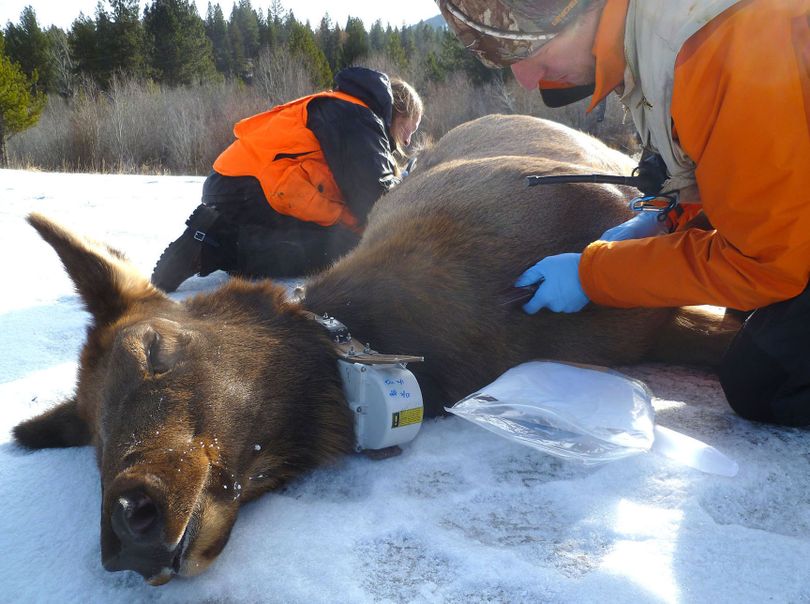Wilderness purests protest Idaho helicopter elk research

WILDLIFE MANAGEMENT -- Backcountry values and modern wildlife management are clashing in Idaho, as wilderness advocates filed a lawsuit Thursday to stop an Idaho Department of Fish and Game plan to land helicopters in the Frank Church Wilderness Area during an elk study this winter.
Here's the story by Eric Barker of the Lewiston Tribune:
The state agency gained approval from the Salmon-Challis National Forest to touch down as many as 120 times in the vast and remote area during a five-day project aimed at placing satellite tracking collars on 60 elk. Motorized travel, including the landing of aircraft outside of grandfathered airstrips, is forbidden under the 1964 Wilderness Act and the Central Idaho Wilderness Act that created the 2.3 million-acre Frank Church-River of No Return Wilderness Area.
But federal managers can make exceptions under a narrow range of circumstances, so long as the action is the minimum required to administer the area. Forest Supervisor Chuck Mark did just that Wednesday following a monthslong environmental review. He was swayed to grant approval because of the state’s jurisdiction over wildlife management and because the landings are to take place when the wilderness area is virtually devoid of visitors – and are thus unlikely to infringe on wilderness characteristics such as solitude.
“Certainly the seasonality thing is huge,” he said. “There is basically nobody back there in the wintertime in regard to recreation. From a solitude standpoint that is a big deal. Obviously, solitude is being disturbed but there is nobody back there to witness the disturbance.”
Mark also approved the landings because he believes the fish and game project, which is designed to learn what is causing a sharp drop in the wilderness elk herd, will help preserve the natural conditions of the area.
Those justifications were sharply rebuked by George Nickas, executive director of Missoula, Mont.-based Wilderness Watch.
“It’s the most intensive helicopter-assisted intrusion in wilderness we have seen in 50 years of the Wilderness Act,” Nickas said. “I don’t think there is anywhere in the national forest system where the Forest Service has approved something like this in wilderness.”
Although the state has management authority over wildlife, he said the department cannot seek to artificially inflate elk numbers or disrupt the natural interplay between elk herds and wolf packs.
“They haven’t hidden at all their ultimate goal is to manage the River of No Return as an elk farm and to wipe out predators as part of that, and this project is part and parcel of that management strategy,” he said.
Wilderness Watch, along with the Moscow-based Friends of the Clearwater and the Hailey-based Western Watersheds Projects, filed their lawsuit late Thursday afternoon in Idaho’s U.S. District Court. In addition to their accusation that the fish and game project violates the Wilderness Act, they contend the Forest Service should have conducted a lengthy environmental impact statement gauging the effects on the ecosystem.
The elk herd in the state’s Middle Fork Zone declined by 43 percent between 2002 and 2011, said Idaho Fish and Game spokesman Mike Keckler at Boise. The state’s usual elk monitoring method of conducting periodic flights to count the animals is insufficient to determine the nature of the problem.
“We want to better understand what is going on back there and this project will help us do it,” he said. “We coordinated with the Forest Service as the land managers under their authority and under our authority as the wildlife managers. They agreed with us that this is a proper activity in the wilderness area.”
Under the state’s plan, elk would be darted or netted from the air. Helicopters would touch down briefly to unload biologists, who would place collars on the animals and take biological samples such as blood. The helicopters would land a second time upon completion of the work to pick up the biologists.
The state won approval in 2010 to land helicopters in the Frank 20 times while putting satellite collars on wolves. Wilderness advocates filed suit then, but U.S. District Judge B. Lynn Winmill sided with the state and Forest Service, saying the project was related to restoring wolves and that the animals were integral to the area’s wild character. However, he warned them that his approval was a rare exception and grounded in the purpose of protecting wilderness character associated with wolves.
In their complaint, filed by the environmental law firm EarthJustice, the groups argued the state’s plan is routine wildlife monitoring aimed at helping it set annual elk and wolf harvest goals. In addition, they said the approval that lets the state immediately begin elk-capturing operations goes against Winmill’s direction in the 2010 case that similar actions in the future should give ample time for legal challenge before they begin.
